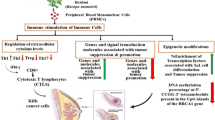Abstract
Previously, the aqueous ethanolic extract (AEE) of unripe fruit of bitter melon (BM; Momordica charantia) was demonstrated to inhibit cytokine-induced apoptosis via modulating Bcl-2 family and caspase cascades in MIN6N8 pancreatic β-cells. Here, it was sought to determine whether the anti-apoptotic effect of AEE-BM is mediated by suppressing the activation of mitogen-activated protein kinases (MAPKs) and nuclear factor-κB (NF-κB), major upstream effectors of Bcl-2 family and caspase cascades, in cytokine-treated MIN6N8 cells. The results exhibited that the AEE-BM suppressed the activation of MAPKs including stress-activated protein kinase/c-Jun N-terminal kinase (SAPK/JNK), p38, and p44/42, and the activity of NF-κB. The findings suggest that BM protects pancreatic β-cells through down-regulation of MAPKs and NF-κB.
Similar content being viewed by others
References
Sarkar S, Pravana M, Maritaa R. Demonstration of the hypoglycemic action of Momordica charantia in a validated animal model of diabetes. Pharmacol. Res. 33: 1–4 (1996)
Krawinkel MB, Keding GB. Bitter gourd (Momordica charantia): A dietary approach to hyperglycemia. Nutr. Rev. 64: 331–337 (2006)
Grover JK, Yadav SP. Pharmacological actions and potential uses of Momordica charantia: A review. J. Ethnopharmacol. 93: 123–123 (2004)
Basch E, Garbadi S, Ulbright C. Bitter melon (Momordica charantia): A review of efficacy and safety. Am. J. Health-Syst. Ph. 60: 356–359 (2003)
Raman A, Lau C. Anti-diabetic properties and phytochemistry of Momordica charantia L. (Cucurbitaceae). Phytomedicine 2: 349–362 (1996)
Riboulet CA, Diraison F, Siew LK, Wong FS, Rutter GA. Inhibition of AMP-activated protein kinase protects pancreatic β-cells from cytokine-mediated apoptosis and CD8+ T-cell-induced cytotoxicity. Diabetes 57: 415–423 (2008)
Kim K, Kim HY. Momordica charantia protects against cytokineinduced apoptosis in pancreatic β-cells. Food Sci. Biotechnol. 17: 947–952 (2008)
Larsen L, Storling J, Darville M, Eizirik DL, Bonny C, Billestrup N, Mandrup PT. Extracellular signal-regulated kinase is essential for interleulin-1-induced and nuclear factor κB-mediated gene expression in insulin-producing INS-1E cells. Diabetologia 48: 2582–2590 (2005)
Tournier C, Hess P, Yang DD, Xu J, Turner TK, Nimnual A, Bar-Sagi D, Jones SN, Flavell RA, Davis RJ. Requirement of JNK for stress-induced activation of the cytochrome c-mediated death pathway. Science 288: 870–874 (2000)
Mandrup PT. β-Cell apoptosis: Stimuli and signaling. Diabetes 50: S58–S63 (2001)
Kim WH, Lee JW, Gao B, Jung MH. Synergistic activation of JNK/SAPK induced by TNF-α and IFN-γ: Apoptosis of pancreatic β-cells via the p53 and ROS pathway. Cell. Signal. 17: 1516–1532 (2005)
Eldor R, Yeffet A, Baum K, Doviner V, Amar D, Ben-Neriah Y, Christofori G, Peled A, Carel JC, Boitard C, Klein T, Serup P, Eizirik DL, Melloul D. Conditional and specific NF-κB blockade protects pancreatic β cells from diabetogenic agents. P. Nat. Acad. Sci. USA 103: 5072–5077 (2006)
Cnop M, Welsh N, Jonas JC, Jorns A, Lenzen S, Eizirik DL. Mechanisms of pancreatic β-cell death in type 1 and type 2 diabetes. Diabetes 54: S97–S107 (2005)
Saldeen J, Welsh N. Interleukin-1 β induced activation of NF-κB in insulin producing RINm5F cells is prevented by the protease inhibitor N α-p-tosyl-L-lysine chloromethylketone. Biochem. Bioph. Res. Co. 203: 149–155 (1994)
Flodstrom M, Welsh N, Eizirik DL. Cytokines activate the nuclear factor κB (NF-κB) and induce nitric oxide production in human pancreatic islets. FEBS Lett. 385: 4–6 (1996)
Giannoukakis N, Rudert WA, Trucco M, Robbins PD. Protection of human islets from the effects of interleukin-1β by adenoviral gene transfer of an Ikappa B repressor. J. Biol. Chem. 275: 36509–36513 (2000)
Kanayama A, Seth RB, Sun L, Ea CK, Hong M, Shaito A, Chiu YH, Deng L, Chen ZJ. TAB2 and TAB3 activate the NF-κB pathway through binding to polyubiquitin chains. Mol. Cell 15: 535–548 (2004)
Yagi N, Yokono K, Amano K, Nagata M, Tsukamoto K, Hasegawa Y, Yoneda R, Okamoto N, Moriyama H, Miki M, Tominaga Y, Miyazaki JI, Yagita H, Okumura K, Mizoguchi A, Miki A, Ide C, Maeda S, Kasuga M. Expression of intercellular adhesion molecule 1 on pancreatic β-cell destruction by cytotoxic T-cells in murine autoimmune diabetes. Diabetes 44: 744–752 (1995)
Di Matteo MA, Loweth AC, Thomas S, Mabley JG, Morgan NG, Thorpe JR, Green IC. Superoxide, nitric oxide, peroxynitrite, and cytokine combinations all cause functional impairment and morphological changes in rat islets of Langerhans and insulinsecreting cell lines but dictate cell death by different mechanism. Apoptosis 2: 164–177 (1997)
Briaud I, Lingohr MK, Dickson LM, Wrede CE, Rhodes CJ. Differential activation mechanisms of Erk-1/2 and p70 (S6K) by glucose in pancreatic β-cells. Diabetes 52: 974–983 (2003)
Ballif BA, Blenis J. Molecular mechanisms mediating mammalian mitogen-activated protein kinase (MAPK) kinase (MEK)-MAPK cell survival signals. Cell Growth Differ. 12: 397–408 (2001)
Kim EK, Kwon KB, Song MY, Seo SW, Park SJ, Ka SO. Genistein protects pancreatic beta cells against cytokine-mediated toxicity. Mol. Cell. Endocrinol. 278: 18–28 (2007)
Raman M, Chen W, Crobb MH. Differential regulation and properties of MAPKs. Oncogene 26: 3100–3112 (2007)
Nakano H, Nakajama A, Sakon-Komazawa S, Piao JH, Xue X, Okumura K. Reactive oxygen species mediate crosstalk between NF-κB and JNK. Cell Death Differ. 13: 730–737 (2006)
Roux PP, Blenis J. ERK and p38 MAPK-Activated protein kinases: A family of protein kinases with divers biological functions. Microbiol. Mol. Biol. R. 68: 320–344 (2004)
Author information
Authors and Affiliations
Corresponding author
Rights and permissions
About this article
Cite this article
Kim, K., Kim, H.Y. Bitter melon (Momordica charantia) extract suppresses cytokineinduced activation of MAPK and NF-κB in pancreatic β-Cells. Food Sci Biotechnol 20, 531–535 (2011). https://doi.org/10.1007/s10068-011-0074-x
Received:
Revised:
Accepted:
Published:
Issue Date:
DOI: https://doi.org/10.1007/s10068-011-0074-x




